Physical Address
304 North Cardinal St.
Dorchester Center, MA 02124
Most Gram-positive skin infections can be treated with a semisynthetic penicillin or a cephalosporin.
Meticillin-resistant staphylococcal infections typically present as abscess or folliculitis. The primary intervention is drainage.
Lyme disease typically presents with erythema migrans and responds to treatment with oral doxycycline. Meningitis or cardiac involvement is treated with intravenous ceftriaxone.
Rickettsial diseases often present with a cutaneous eruption, fever, and headache. The treatment drug of choice is doxycycline, and in the case of Rocky Mountain spotted fever the presence of fever and headache in an endemic area should prompt treatment.
Systemic diseases caused by bacteria produce a variety of cutaneous changes. Dermatologic sequelae may result from bacterial toxins, from hypersensitivity reactions, or from direct cutaneous spread of organisms. Often, the changes produced are highly characteristic and allow for a prompt diagnosis and institution of therapy.
The characteristic eruption of scarlet fever typically follows infection with group A β-hemolytic streptococci that produce an erythrogenic toxin. Specific antibodies synthesized in response to the toxin confer immunity.
Scarlet fever occurs predominantly in children and typically follows streptococcal pharyngitis or tonsillitis. The characteristic cutaneous eruption consists of punctate erythematous papules, resulting in a sandpaper texture. The eruption begins on the neck and spreads caudally to involve the trunk and extremities. The palms and soles are generally spared. The face appears flushed, with a circumoral pallor. Petechiae may be present in creases of the elbows, groin, and axillae, a finding commonly referred to as Pastia’s lines. The eruption begins to fade after 4 to 5 days with residual desquamation. A “white strawberry” tongue, consisting of prominent, swollen red papillae, appears in the first few days of the illness. This is followed by desquamation leading to the “red strawberry” tongue. Cervical adenopathy and fever are usually present.
The diagnosis can be confirmed by positive culture showing infection with group A streptococci. Increases in serum levels of antistreptolysin O and anti-DNase B also help confirm recent streptococcal infection.
Penicillin is currently the treatment of choice. Erythromycin may be used in penicillin-sensitive patients.
Rheumatic fever is a sequela of an upper respiratory infection with group A streptococci. The disease is characterized by inflammatory lesions affecting the joints, heart, skin, and central nervous system. The peak age incidence is 5 to 15 years and the recurrence rate in affected individuals is high.
The clinical manifestations of acute rheumatic fever include erythema marginatum, subcutaneous nodules, polyarthritis, carditis, and chorea. The latency period between the antecedent streptococcal pharyngitis and the onset of symptoms of acute rheumatic fever is about 3 weeks. Erythema marginatum begins as an erythematous macule or papule that extends centrifugally as the central areas clear. Adjacent lesions may coalesce and form a serpiginous pattern. The lesions are evanescent, but the overall eruption may persist for weeks. The subcutaneous nodules are firm, painless lesions varying in size from a few millimeters to a few centimeters. The overlying skin is freely movable and is not inflamed. These lesions occur in crops over bony prominences or tendons.
The diagnostic criteria originally defined by Duckett Jones use major and minor criteria to support the diagnosis with a high degree of probability.
Treatment with penicillin within 1 week of the onset of sore throat may prevent the subsequent onset of rheumatic fever. Antibiotics do not modify the course of an acute rheumatic attack. Acute rheumatic fever may be treated with systemic corticosteroids or supportively with nonsteroidal anti-inflammatory drugs. Prophylaxis with low-dose penicillin effectively prevents recurrence.
Erysipelas is a superficial dermal infection with group A streptococci, whereas cellulitis occurs slightly deeper in the dermis.
Both cellulitis and erysipelas present most commonly on a lower extremity. Facial skin can also be involved, frequently following minor trauma ( Fig. 32-1 ). The characteristic cutaneous lesion is edematous, well demarcated, and dusky red, and may have bullae at the advancing edge. The patient may have toxemia and a high fever. Recurrent erysipelas is strongly associated with lymphedema.
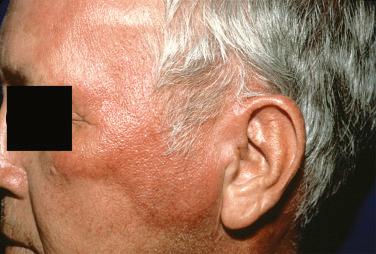
This diagnosis is largely made on clinical grounds, as isolation of the organism can be difficult. Bilateral disease rarely represents cellulitis and should prompt consideration of alternate diagnoses, especially lipodermatosclerosis. Streptococci cause erysipelas and the majority of cases of cellulitis, while a minority (especially bullous lesions) are caused by staphylococci. Biopsy specimens of the skin reveal dermal edema and a neutrophilic infiltrate.
Semisynthetic penicillins or intravenous crystalline penicillin (in the case of erysipelas) are commonly used. Cephalosporins can be used in milder cases of cellulitis and clindamycin is recommended when toxin production is suspected. In penicillin-sensitive individuals, erythromycin may be used.
Impetigo is a superficial skin infection characterized by honey-colored crusting or subcorneal bullae. Streptococci probably initiate most cases of nonbullous impetigo, but may be rapidly outnumbered by Staphylococcus aureus once the skin barrier has been breached.
Honey-colored or dark crusts on an erythematous base are typical ( Fig. 32-2 ). In bullous impetigo, the blisters are so superficial that they rarely remain intact and patients typically present with round denuded areas with peripheral adherent scale ( Fig. 32-3 ).
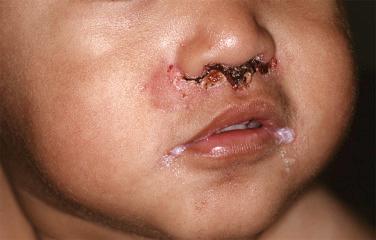
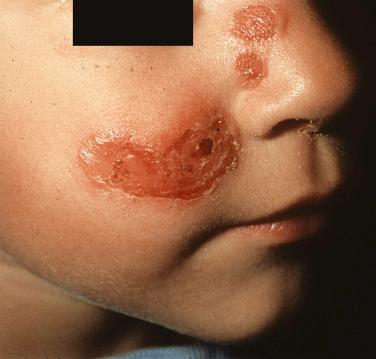
Bacterial culture from affected areas will typically yield the causative organism but most patients are treated empirically without culture.
Limited cases may be adequately treated with topical antibiotic ointments such as mupirocin or retapamulin. Extensive lesions require systemic antibiotics. Penicillinase-resistant penicillins or cephalosporins represent good first-line therapy although other choices are sometimes appropriate based on the local antibiogram.
A furuncle represents a follicular staphylococcal abscess ( Fig. 32-4 ). A carbuncle is formed by a coalescence of furuncles. Patients with recurrent furunculosis are often nasal carriers of S. aureus , but skin surface carriage in moist areas such as the axilla, groin, and umbilicus may be equally important.
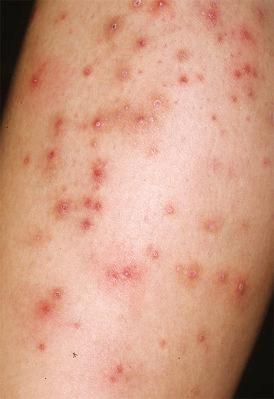
Individual lesions should be drained. Widespread lesions require the addition of a penicillinase-resistant penicillin or a first-generation cephalosporin. Meticillin-resistant organisms ( Fig. 32-5 ) should be suspected if the lesions do not respond promptly. Staphylococcal carriage may be treated with mupirocin ointment applied to the anterior nares daily for 5 days and a topical antiseptic such as chlorhexidine or bleach baths (1/4 cup per 1/2 tub) can be used to reduce skin surface carriage. Recent data also support daily oral gargles to control oropharyngeal carriage.
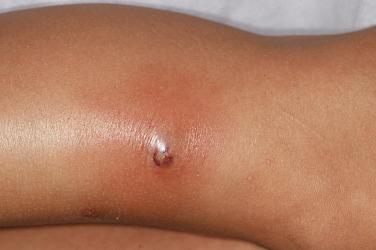
Staphylococcal scalded skin syndrome (SSSS) is caused by an exotoxin produced by S. aureus , most commonly group II phage type 71. Most patients are children, and most adults with the disorder have renal failure making them unable to eliminate the toxin.
Become a Clinical Tree membership for Full access and enjoy Unlimited articles
If you are a member. Log in here